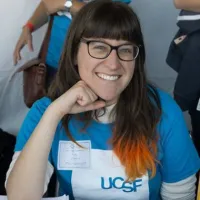
Blinded By Snow
Imagine waking up one morning with static, like what you would see on an old television screen, flickering over your entire field of vision. It’s constant, and even shutting your eyes offers no relief.
You experience other symptoms too, severe headache, dizziness, confusion, and nausea.
When this phenomenon persists, you go to an ophthalmologist, a neurologist, the hospital. You describe your symptoms and have vision tests, a CT scan, blood tests, a lumbar puncture, but after all this you still don’t have any answers. You’re dismissed by doctors as making everything up and friends and family tell you to just get over it.
This experience is what many patients with the rare neurological condition Visual Snow Syndrome have to endure, and one patient, Sierra Domb, wanted to change this.
To raise awareness for this condition, Domb organized the first ever Visual Snow Conference, which will take place on Saturday, May 5, 2018 in the Mission Bay Conference Center at UCSF.
This one day comprehensive conference aims to bring individuals with visual snow, their families, and the medical community together to learn about the current issues and latest research on this condition.
Professor of neurology at UCSF/King’s College and worldwide visual snow expert Dr. Peter Goadsby, who drafted the first diagnostic criteria and conducted the first imaging studies for people with visual snow, will lead a session to dispel myths about the condition and provide a progress report on the latest research being conducted
Other speakers include:
Dr. Victoria Pelak, professor of neurology and ophthalmology at the University of Colorado School of Medicine who specializes in the diagnosis and management of patients with neurological disorders that affect vision and eye movements;
James Fulton, research professional and author of “Processes in Biological Vision” with more than 30 years of experience analyzing the human eye; and
Matthew Renze, data science consultant, author and international public speaker who will offer insights and solutions based on his own case of visual snow.
Conference speakers and organizers alike encourage you to join them on May 5 and start working together to build awareness, education, and support of those dealing with visual snow. The conference is open to the public free of charge and you can register to attend here.
For more information, resources, and real stories you can visit The Visual Snow Foundation’s website.



